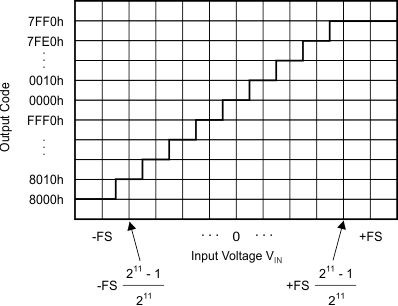JAJSE50 November 2017 TLA2021 , TLA2022 , TLA2024
PRODUCTION DATA.
- 1 特長
- 2 アプリケーション
- 3 概要
- 4 改訂履歴
- 5 概要(続き)
- 6 Device Comparison Table
- 7 Pin Configuration and Functions
- 8 Specifications
- 9 Detailed Description
- 10Register Maps
- 11Application and Implementation
- 12Power Supply Recommendations
- 13Layout
- 14デバイスおよびドキュメントのサポート
- 15メカニカル、パッケージ、および注文情報
9.5.3 Data Format
The TLA202x provide 12 bits of data in binary two's-complement format that is left-justified within the 16-bit data word. A positive full-scale (+FS) input produces an output code of 7FF0h and a negative full-scale (–FS) input produces an output code of 8000h. The output clips at these codes for signals that exceed full-scale. Table 4 summarizes the ideal output codes for different input signals. Figure 15 shows code transitions versus input voltage.
Table 4. Input Signal Versus Ideal Output Code
| INPUT SIGNAL
VIN = (VAINP – VAINN) |
IDEAL OUTPUT CODE(1) |
|---|---|
| ≥ +FS (211 – 1) / 211 | 7FF0h |
| +FS / 211 | 0010h |
| 0 | 0000h |
| –FS / 211 | FFF0h |
| ≤ –FS | 8000h |
 Figure 15. Code Transition Diagram
Figure 15. Code Transition Diagram NOTE
Single-ended signal measurements, where VAINN = 0 V and VAINP = 0 V to +FS, only use the positive code range from 0000h to 7FF0h. However, because of device offset, the TLA202x can still output negative codes in case VAINP is close to 0 V.